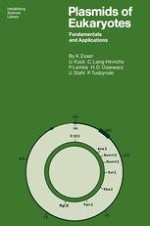The possession of plasmids was for a long time recognized only in the bacteria. It is now evident that plasmids, or replicative forms of DNA structurally and experimentally comparable to bacterial plasmids, exist in eukaryotic organisms as well. Such plasmids are in fact common among fungi and higher plants. The present review is undertaken to provide a comprehensive account of the data available on plasmids found in eukaryotic organisms. This review will not consider plasmids of prokaryotic origin, even though certain bacterial plasmids, such as the tumor-inducing (Ti) plasmids of Agrobacterium tumefaciens, may be intimately associated with transformation of the eukaryotic host. This book, moreover, does not consider transformation experiments in eukaryotic hosts involving viral DNA as vectors, although indeed such vectors have been developed for use in plant and animal systems. After a general introduction, providing historical perspective on the nature and role of plasmids, a list of eukaryotic plasmids will be presented according to their origin. This is followed by a detailed discussion of known structure and function. In subsequent chapters the practical implications of eukaryotic plasmids for molecular cloning and biotechnology will be discussed. This latter part traces the development of interest'in biotechnical genetics and gives special consideration to the use of eukaryotic systems for gene cloning. The terminology biotechni cal genetics is introduced to the reader and is used in a general sense as equivalent to genetic engineering. Biotechnical genetics includes, but is not limited to, gene cloning through recombinant DNA technology.
